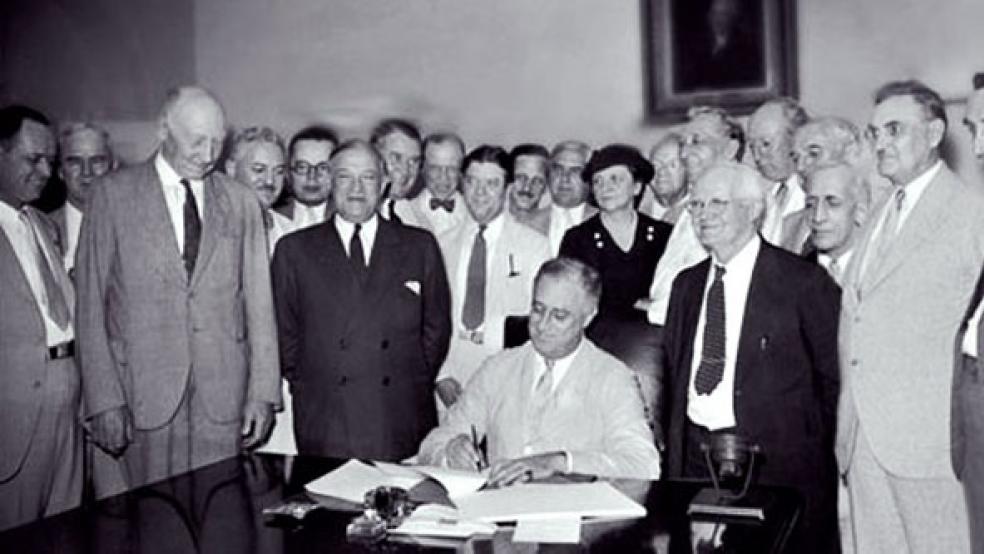Untold trillions of dollars and exactly three-quarters of a century ago, Franklin D. Roosevelt signed into law arguably the most significant legislation of the 20th century — Social Security. After winning lopsided approval in Congress, FDR put his pen to the Social Security Act on August 14, 1935, declaring: “We have tried to frame a law which will give some measure of protection to the average citizen and to his family against the loss of a job and against poverty-ridden old age.”
The idea had been in the air, dating from Teddy Roosevelt’s 1912 campaign calling for old-age and unemployment insurance, and later with state efforts by FDR and New Hampshire’s Republican governor John Winant and others to implement public pensions. However, federal action was driven not only by the Roosevelt Administration, but by crushing poverty among the elderly. “The Depression, the so-called ‘thunder on the left’ by Francis Townsend and others, and the huge Democratic majorities in Congress,” drove the agenda, according to Robert Griffith, chair of American University’s history department.Today, this multifaceted, much-amended social insurance compact is the world’s largest government program, spending $752 billion this year on benefits for 60 million Americans. Immensely popular, and sacrosanct to lawmakers, it is — along with Medicare and Medicaid — nonetheless at the center of the nation’s growing fiscal crisis. The three entitlement programs consume almost $1.5 trillion, or nearly 40 percent, of the federal budget. Their share is rising, meaning ever greater deficits unless taxes are increased, other federal programs take draconian cuts, or the programs are reformed. Indeed, they are headed toward insolvency in the absence of reform — which is high on America’s policy agenda (as it has been for much of the last 30 years).
Although experts believe that reforms to achieve long-term sustainability are relatively easy compared with reining in Medicare, Medicaid and health care costs in general, the public is less sanguine, and policymakers have been loath to act. Only 36 percent of Americans believe they will receive benefits when they retire, according to a July USA Today poll. The program’s apparent problems are legion. It already pays out more than it takes in, with trillions of dollars in unfunded liabilities looming ahead. With an aging population, the ratio of workers to beneficiaries is declining. Social Security is seen by many as unfair because high-earners are exempt from much of the payroll tax and the wealthy draw benefits, while tens of millions scrape by on average monthly payments of barely $1,000. A high proportion of Americans depend overwhelmingly on Social Security when they retire because other traditional supports for retirement security — employer-provided pensions and savings — have declined since the 1980s.
Political leaders may be prodded reluctantly to make changes after President Obama’s National Commission on Fiscal Responsibility and Reform reports in December, but any reforms are unlikely to sail through as they did in 1935. Back then, despite Huey Long’s Share Our Wealth leftist alternative plan and conservative attacks by the likes of the National Association of Manufacturers, who called it the “ultimate socialistic control,” the legislation enjoyed a comparative glide path to passage.
Roosevelt also wanted revenues and expenditures to match, saying it would be “dishonest to build up an accumulated deficit.”
Roosevelt had created a Committee on Economic Security in 1934, led by Labor Secretary Frances Perkins. An initial November 1934 convening of some 200 business, labor and academic experts followed FDR’s call to base the program on “insurance principles.” Cynthia Koch, director of the FDR Presidential Library and Museum, said, “He wanted it to be universal and an economic right, not a dole.” But Roosevelt also wanted revenues and expenditures to match, saying it would be “dishonest to build up an accumulated deficit.” These ideas were quickly translated into the Economic Security Act of 1935, although a public health insurance proposal was dropped.
Introduced on Jan. 17, 1935, by New York Sen. Robert Wagner, Pennsylvania Rep. David J. Lewis and North Carolina Congressman Robert L. Doughton, congressional hearings began within four days and the legislation’s name was changed to the “more alliterative” Social Security Act, according to Nancy Altman, author of The Battle for Social Security. Reported out of House and Senate committees in the spring of 1935, the bill was taking shape: It would include old age, unemployment and disability insurance.
Over succeeding decades, a plethora of amendments have expanded the program. On April 19, the House resoundingly voted 371-33 in favor of the legislation, winning strong Republican support. Despite late controversies about including an opt-out provision for old-age insurance, the House-Senate conferees’ report passed on August 8 and 9. Five days later, FDR signed the bill, asserting that it “would be regarded as historic for all time.” It was the rare example of a politician who did not exaggerate his achievement.
Andrew L. Yarrow is the author of Forgive Us Our Debts: The Intergenerational Dangers of Fiscal Irresponsibility.



